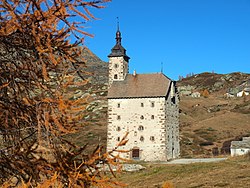Old Hospice (Simplon)
| Old hospice | ||
|---|---|---|
 The old hospice |
||
| Data | ||
| place | Simplon village | |
| builder | Kaspar Stockalper | |
| Construction year | around 1650 | |
| height | 25 - 30 m | |
| Coordinates | 644 487 / 120588 | |
|
|
||
The old hospice at the Simplon Pass , also called the Alter Spittel , was built by Kaspar Stockalper around 1650 . Kaspar Stockalper also had the Stockalper Tower built in Gondo . Stockalper was a businessman who shaped the Simplon Pass and the entire region. Among other things, he had trade relations with Italy and France and it was he who set up the courier service with horse mail across the Simplon Pass between Milan and Geneva in 1640. Stockalper built the Stockalperpalast of Brig .
The construction

The old hospice is a five-storey building made of solid granite . Together with the Stockalper Tower in Gondo , it served as a shelter for travelers and commercial travelers. At that time, a mule track led across the Simplon Pass , some of which is still accessible today. The path is known today as the Stockalperweg . The house should provide protection for people, goods and pack animals . In one direction, fabrics and spices were transported, in the other direction, wool and dried meat, among other things. A house chapel with a small baroque altar is located under the gable above the fifth floor . A tower with a bell tower is integrated in the building on the northwest side. The bell can still be rung by hand with a rope. Inside the tower is the staircase. There are entrances to the house on three facades. The main entrance is on the south-east facade. A niche is attached to the outer wall above the main entrance, in which there was probably a statue of a saint in earlier times. The main entrance leads into a large entrance room, at the end of which the relatively wide granite staircase leads up. The rooms on the various floors are described in detail in the brochure Das Alte Hospiz on the Simplonpass VS. The floors are divided into smaller and larger rooms, often clad in wood. On the second floor, in a living room clad in wood, there is a soapstone stove that used to be fired by the kitchen next to it.
In 1801 Napoleon ordered that a hospice, similar to the one on the Great St. Bernhard, be built on the Simplon Pass and run by the monks. In 1809 the monks established themselves in the old hospice. Construction of the new hospice began in 1811, but due to Napoleon's fall in 1812 and lack of money, it was not completed until 1835.
location
The old hospice stands on a ledge at the foot of the Hübschhorn at 1870 m above sea level. M. 1.6 km southwest of the Simplon Pass summit. The mule trains had of Brig Coming the pass to cross first before they came to the protective construction. The main entrance of the old hospice was exactly on the mule track . The pass road rebuilt by Napoleon from 1801 to 1805 led 160 meters east of the building and higher up past the old hospice. At this point, today's pass road follows the old Napoleon road, which is already ideally laid out in its lines. For passers-by, an exit was built on today's pass road above the old hospice so that motorists or motorcyclists can stop and take a look at the old hospice.
present
In 1980 the old hospice was bought and restored by the Federal Military Department . Among other things, a safety staircase was installed in the house near the tower. The small, old, no longer functional kitchen was replaced on the ground floor by a modern team kitchen. The building is now used as troop accommodation and it can be rented by the military for events or for holiday and school camps. The old hospice was added to the list of cultural assets of national importance.
Web links
- Old hospice (Simplon) on the ETHorama platform
Individual evidence
- ↑ a b The old hospice on the Simplon VS, Martin Fröhlich and Walter Haab, Society for Swiss Art History, 3012 Bern. ISBN 3-85782-410-7 .


